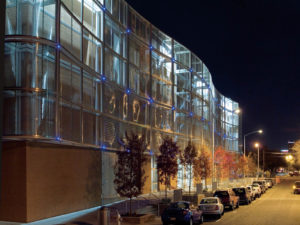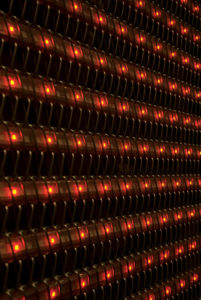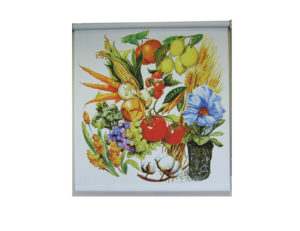
The days of Grandma’s stiff, vinyl rollup shades and the heavy-duty bug screen you could hardly see through are gone. Today’s shades and screens are made from an array of energy-efficient fabrics and designed with not just functionality but aesthetics, sustainability and even a little fun in mind. These high-tech fabrics can turn a parking garage into a work of stunning architecture and your garage into a bug-free outdoor room. A window that sported a standard shade can now feature a favorite family photo while reducing energy costs. Here’s a look at some of the latest trends.
Screens improve the outdoors
As outdoor rooms continue to grow in popularity, so has the realization that the outdoors can be, well, hot and swarming with bugs. To improve on what Mother Nature has to offer, Phantom Screens, based in Abbotsford, British Columbia, has introduced Executive Screen.
Made of fiberglass and coated with PVC for durability, Executive Screen is a versatile, retractable screen system that can be used to enclose open or oversized spaces, including garages, covered patios, balconies, porches or decks. A roller housing protects the screen when it’s not in use. With the touch of a button, the screen comes down on tracks made of extruded aluminum that can be color-matched to complement a business or home. The system can be exterior mounted or recessed into a ceiling cavity or walls.
“This is not a new product, but we’re using it in new ways and we’re seeing a lot of interest,” says Jeret Unger, marketing and communications manager for Phantom Screens. In addition to blocking ultraviolet rays and keeping the bugs away, Unger says, Executive Screen allows complete ventilation while enhancing privacy and helping to create sealed, safe places for things like a workshop or a kids’ playroom. The screen can also be used indoors to cover oversized picture windows or to block light in a home theater.
Woven mesh saves energy
Cambridge Architectural has been manufacturing woven metal products for industrial use for decades. But in the last few years, the company’s woven mesh systems have captured the attention of architects who have used the metal fabric in a variety of innovative ways.

At the New World of Coca-Cola®museum in Atlanta, Ga., for example, Cambridge designers and engineers worked closely with the project’s architects to create a series of 8-foot-by-8-foot woven mesh fabric panels that were installed in conjunction with a glass curtain wall to create the building’s contemporary facade. Cambridge used lasers to etch the Coca-Cola trademark onto the surface of the fabric. At night, exterior wash lighting gives the building a luminescent glow.
Made from textured stainless steel, Cambridge’s woven wire mesh is an increasingly popular choice for building facades because it looks attractive while offering both shade and energy savings. “We’ve done a lot of testing so we can tell people what kind of energy savings they’ll get when using a particular mesh product,” says Larry Windsor, director of sales and business development for Cambridge Architectural.
The fabric, which can be woven as large as 200 feet tall and 20 feet wide and installed with limited support, is also used frequently in the construction of parking garages. “The textured metal offers a stylish option to traditional concrete-clad parking structures,” Windsor says. “And it’s open, so you get a cool look while often eliminating the need for an HVAC system.”
Indoors, Cambridge’s metal fabrics can be used in commercial and residential settings in a variety of ways, including infill on handrails, wall cladding and ceilings. The company’s new Reelease™ technology, a custom-designed, motorized retractable attachment system, has even made it possible to use the material as curtains that can be raised or lowered at the touch of a button. “Right now,” Windsor says, “the sky is the limit with this material. It’s really caught on.”
Digitally printed shades beat the heat
Located in Mt. Vernon, N.Y., Beards-Cosden Co. Ltd. is known for manufacturing a wide selection of stock and custom window shades. For those looking for something fun and functional, the company’s customized, digitally printed shades may be just the thing.

LED lighting can be used to create dynamic visual effects on all types of metal-clad facades. Lightweight metal mesh fabric is a good choice for incorporating LEDs because the mesh helps hold the strips of lights in place without obstructing their glow. Photo: Cambridge Architectural.
Beards-Cosden can imprint everything from family photos or favorite artwork to company logos and advertising graphics onto their solar window shades. Made from a blend of fiberglass and vinyl, solar shades come in a variety of colors, though the company generally recommends white for digitally printed photos. Logos look best on light shades of beige and gray. “People like to put something personal on their shades,” company president Nick Cunningham says. “I’ve got a picture of my kids on a shade [displayed] on our Web site. We see a lot of people bringing in photos and art they like, especially for shades in kids’ rooms.”
Depending on the density of the weave, solar shades block varying degrees of heat and ultraviolet rays, reducing energy costs. They also cut down on glare without obstructing the view.
Digital printing is done off-site, Cunningham says, using customer-supplied TIF or JPG files for photos and artwork or EPS or Adobe Illustrator files for text and graphics. Once the fabric is printed, it is returned to Beards-Cosden, where the shades are made.
Customers often request large custom-printed shades, and Beards-Cosden does offer fabrics in roll widths up to 98 inches. But image quality and resolution often limit shade size. Depending on the image and shade size, it is sometimes possible to create a panorama over several shades, Cunningham says.
Eco-screens leave a clean footprint
Sustainable design is a priority for more and more companies. Dothan, Ala.-based Twitchell Corporation has introduced screen products created with Earthtex®yarn and fabric. Made from thermoplastic olefin (a polymer/filler blend known as TPO), Earthtex offers the durability and performance of traditional PVC and fiberglass screens without releasing harmful chemicals into the environment.
“It’s great because it’s completely recyclable, which means it can be broken down into its elemental compounds and reprocessed,” explains Jeff Register, Twitchell’s vice president of sales and marketing. “It is virtually unparalleled in the industry today.” Which is why, Register says, the product earned Charlottesville, Va.-based McDonough Braungart Design Chemistry LLC’s Cradle to Cradle™ Silver-level certification for eco-effective design and manufacture.

Register says Earthtex’s eco-friendly appeal is further enhanced by Twitchell’s commitment to transferring all of the power used to produce the fabric to alternate energy sources, including solar and hydroelectric power.
Long Island City, N.Y.-based MechoShade Systems Inc. used Earthtex to make its EcoVeil™ solar shade cloth product, which is currently installed at several commercial locations, including Google headquarters in Mountain View, Calif., and BP Oil headquarters in London.
Twitchell is exploring ways to use Earthtex for other applications, such as floor and wall covering, panel fabric and automotive interiors, Register says, and the company expects the product to appeal to residential customers, too. “We are a technical solution provider for our customers,” Register says. “So we’re very willing to develop and create new products for people’s specific needs.”
 TEXTILES.ORG
TEXTILES.ORG





